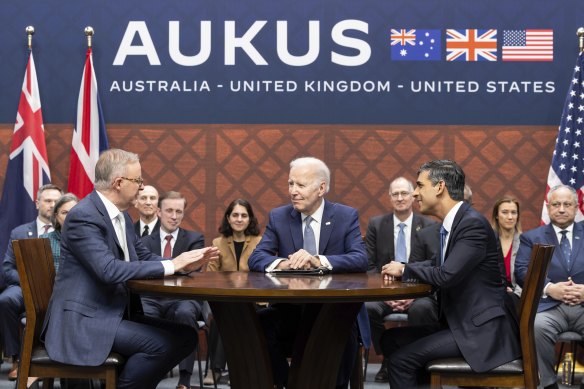Save articles for later
Add articles to your saved list and come back to them any time.
The articles are extremely negative about AUKUS – the Australian, UK and US submarine-propelled alliance – and they circulate on disinformation networks on social media.
One website calls it “a particularly biased development” and likens it to the QUAD group, “which arrogantly denigrates China as a hemispheric threat … turning reality on its head”.
But the accounts aren’t aimed at English speakers.
The commentary, pushed by Russian Telegram accounts, is posted in Spanish. It is aimed at audiences in Latin America already distrustful of the US, Britain and their allies.
AI can be used to fight fake news.Credit: Marija Ercegovac
This material was discovered by a search tool that employs artificial intelligence, helping expose the drumbeat of anti-Western propaganda flowing across social media. At any time, this flow can be amplified, or directed at a target, to cause confusion or disruption.
The use of AI, which can sift and summarise large volumes of posts across languages and platforms, can discover the potential narratives used to attack a country, company, institution, politician, or even idea – such as the AUKUS alliance.
Prime Minister Anthony Albanese, US President Joe Biden and UK Prime Minister Rishi Sunak in San Diego.Credit: Alex Ellinghausen
To date, the emergence of AI has raised fears for the impact of deepfakes on public communications and privacy. But the technology is also useful in ferreting out deliberately false or slanted information.
Osavul co-founder Dmytro Bilash.Credit: Osavul
Armed with the knowledge, governments, militaries and parties are better able to refute a malign narrative before it goes viral in the public sphere.
Part of the issue is how “bad” information is spread.
Dmytro Bilash, co-founder of counter manipulation company Osavul, says that if, for example, a well-known politician lies, the world is aware of their words and can challenge them. (Think of the endless fact-checks of Donald Trump.)
Bilash says: “What brings harm is a malicious narrative that is not seen and not responded to … and that can bring actual action.”
For example, for years, claims that 5G technology was inherently dangerous were considered too fringe for news outlets to cover.
Then protests, vocal opposition and even vandalism began to mar the rollout of the new wireless technology, which has been deemed scientifically safe.
Anti-5G activism later flowed into violent anti-vaccine and anti-lockdown protests during the COVID-19 pandemic.
What was, at first, false content from the margins grew to become a catalyst for action.
Likewise, years before Russia re-invaded Ukraine in 2022, Moscow spread the lie that its neighbour was run by Nazis. This false claim confused Western nations, making them reluctant to act.
Bilash says “disinformation is like a computer virus, but for media”.
The deliberately false information clouds the public’s ability to know.
Bilash says the viral nature of information today means that even a narrative debunked in the past can, with enough fresh attention, begin to recirculate to new audiences.
AI technology lets Osavul parse volumes of information being pushed in a co-ordinated manner far out of sight of any single set of human eyes. Being made in Ukraine also has its advantages. Ukraine is at war with Russia, which is a propaganda superpower, of sorts.
“We have wartime experience with this and a unique dataset on the threats,” says Bilash.
Of course, AI is not magic. And information, especially political information, is uniquely two-sided. Simply amplifying the volume of true information in a disproportionate way can have a damaging strategic effect.
AUKUS involves nuclear-powered submarines, and so, of course, there is risk.
However, hyping a real risk out of proportion can have a strategic effect – for example, keeping AUKUS leaders on the defensive about the project.
Dmytro Plieshakov, CEO of Osavul.
At the outset of the Ukraine war, Bilash managed a team of AI engineers for marketing. After his house in Kyiv was almost destroyed by Russian missiles, he thought: “Maybe marketing isn’t so important right now.”
Along with Osavul co-founder Dmtryo Plieshakov, he began repurposing the technology to sift out false narratives being generated in the Russian-language information space, before they circulated widely.
Osavul counts among its clients the Kyiv-based Centre for Countering Disinformation at the National Security and Defence Council of Ukraine and US government organisations and NGOs. It has a staff of nearly 20, the bulk of them engineers, primarily in Kyiv.
Its analysts oversee the technology to help it interpret narratives and weed out errors. Warning targets has helped Ukraine hose down false ideas before they gain traction.
And these have real impacts.
A few weeks ago the technology helped head off a surge in false news that a military coup was afoot in Ukraine before the disinformation could take root and trigger real-world denials, reassurances, doubt and confusion.
Ukrainian soldiers in Avdiivka, Ukraine, on Thursday. Both Ukraine and Russia have recently claimed gains in the Avdiivka, where Russia is continuing a long-running campaign to capture the city located in the Donetsk region. Credit: Getty Images
Osavul isn’t the only company working in this area.
US-based Blackbird AI is also making a name for itself, using AI to detect malicious and co-ordinated narratives that can target companies and governments.
Other companies doing similar work include Logically.ai, VineSight, ActiveFence and Primer.
The companies are being set up against a backdrop of fear over what the rise of AI-enabled deepfakes, or chatbots, will eventually lead to.
“Given the degree of trust that society places on video footage … deepfakes could affect not only society but also national security,” says US think tank RAND.
Imagine a nuclear crisis with, say North Korea, in which social media is flooded with false AI-generated content. The public and, importantly, governments could be deceived about whether a missile strike or national security incident has occurred.
One researcher estimates “that nearly 90 per cent of all online media content may be synthetically generated by 2026”.
For this reason, David Gioe, visiting professor of intelligence and international security at King’s College London, and Alexander Molnar, a US Army cyber officer, wrote for British think tank RUSI saying it is possible that “instead of identifying fake news polluting a stream of otherwise legitimate content, we must realise that the stream will soon be the lies, and the truth will need to be plucked out”.
That is already happening around the conflict in Ukraine.
It’s also happening in the war between Israel and Gaza, where each side seeks to spin facts to their advantage in the realm of public perception, often regardless of the facts on the ground, however obscured they may be.
As AI enables new waves of fakery on the internet, AI may also provide the tools for navigating it.
Get a note directly from our foreign correspondents on what’s making headlines around the world. Sign up for the weekly What in the World newsletter here.
Most Viewed in World
From our partners
Source: Read Full Article







